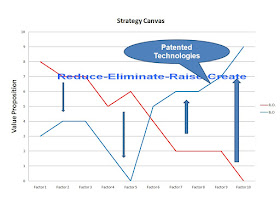I. Disruptive IoT Innovation
HBS professor Clayton M. Christensen coined
the concept of the “disruptive innovation.” Christensen explained the
disruptive innovation in his famous book “The Innovator’s Dilemma” as an
innovation that disrupts an existing market in ways that the market does not
expect, and eventually create a new market. PCs replaced the mainframe
computers, 3.5 inch floppy disk drive replaced 5.25 inch drive and digital
cameras replaced film cameras are some examples of the disruptive innovation.
Key features of the disruptive innovation that differentiate it from the
traditional (sustaining) innovation are as follows.
·
The
products/services provided by the disruptive innovation underperform demanded
by the current mainstream market. Thus, the incumbents in the current market
ignore the opportunities provided by the disruptive innovation. The speed of
performance improvement of the disruptive innovation is, however, faster than
that of the traditional innovation supporting the current market demand. Thus,
the products/services provided by the disruptive innovation can serve the
future market demand.
·
The
performance of the products/services provided by the disruptive innovation does
not need to surpass the performance of the products/services provided by the
traditional innovation. The products/services provided by the disruptive
innovation will create a new market by either offering comparable performance
or meeting the customer’s expectation at lower cost.
Interconnected IoT (Internet of Things)
devices enable the development of the disruptive products/services by meeting
the customer’s expectation at lower cost. For example, a prefabricated house
with built-in IoT applications for the smart home can provide the comparable
quality of life at lower cost. Interconnected IoT (Internet of Things) devices
also can provide the disruptive products/services by offering comparable
performance. For example, the telemedicine system equipped with interconnected
low cost medical devices can offer comparable performance of the traditional healthcare
system with high cost and high performance medical devices.
II. Patent Exploitation for the Disruptive
IoT Innovation
One way of exploiting patents for the
development of the disruptive IoT products/services is to open patents owned by
the incumbents to the business ecosystem collaborators in diverse industries
(the “Open IP Innovation”). By letting the collaborators develop the disruptive
IoT products/services exploiting incumbents’ patents, the incumbents can keep
focusing on the current mainstream market in addition to effectively prepare
the emerging market created by the disruptive IoT innovation. A practical
method to exploit patents for the development of the disruptive IoT
products/services through the Open IP Innovation is to apply the new
product/service development methodology in the “Blue Ocean Strategy” (the “Blue
Ocean Patent Strategy”).
In “Blue Ocean Strategy,” the authors provide
a framework and tool set for creating new products/services, and thus a new market
(blue ocean), through the value innovation such that maximize the value
proposition and minimize the cost to provide the value to customers. To achieve
the value innovation the authors suggest the companies ask the following four
questions (eliminate-reduce-raise-create framework):
a. Which of the factors that the industry
takes for granted should be eliminated?
b. Which factors should be reduced well below
the industry standard?
c. Which factors should be raised well above
the industry standard?
d. Which factors should be created that the
industry has never offered?
These four questions can be converted into
the strategy canvas (level of value proposition v. value proposition factors)
to create a new value curve. In “Blue Ocean Strategy,” the authors use strategy
canvas to analyze the competitive environment of the market (red ocean).
Drawing a strategy canvas does three things. First, it shows the strategic
profile of an industry by depicting very clearly the factors that affect
competition among industry players (BLUE OCEAN FACTORS). Second, it shows the
strategic profile of current and potential competitors, identifying which
factors they invest in strategically. Finally, it shows the company’s strategic
profile- or value curve-depicting how it invests in the factors of competition
and how it might invest in them in the future.
The basic principle in the Blue Ocean Patent
Strategy is to exploit patents to achieve the value innovation by using the
patented technologies to create a new value curve, and thus, to provide new
products/services. Following figure illustrates the basic principle of the blue
ocean patent strategy.
For example, a company in the consumer
electronics industry that wants to develop the IoT medical devices can exploit
existing patents that cover the factors of the strategy canvas. By deciding
which factors (that are covered by the existing patents) are really crucial,
and thus, needed to raise and/or create the value curve, new medical devices
that serve the customers in fundamentally different ways can be developed.
Patents regarding superior UI/UX, compact/portable design, robust wireless
connectivity are the good candidates for the BLUE OCEAN FACTORS. The
exploitation of existing patented technologies not only allows the low cost IoT
medical devices development but also provides the protection against
competitors’ infringement.
For details regarding the patent strategy for
the disruptive IoT innovation, please contact Alex G. Lee
(alexglee@techipm.com).
©2015 TechIPm, LLC All Rights Reserved
http://www.techipm.com/


No comments:
Post a Comment